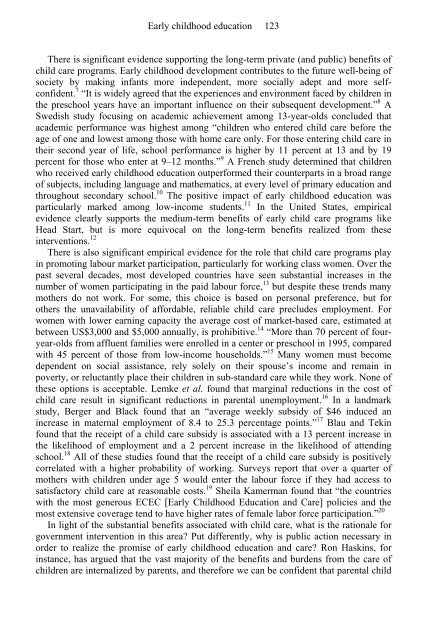Rethinking the Welfare State: The prospects for ... - e-Library
Rethinking the Welfare State: The prospects for ... - e-Library
Rethinking the Welfare State: The prospects for ... - e-Library
You also want an ePaper? Increase the reach of your titles
YUMPU automatically turns print PDFs into web optimized ePapers that Google loves.
Early childhood education 123<br />
<strong>The</strong>re is significant evidence supporting <strong>the</strong> long-term private (and public) benefits of<br />
child care programs. Early childhood development contributes to <strong>the</strong> future well-being of<br />
society by making infants more independent, more socially adept and more selfconfident.<br />
7 “It is widely agreed that <strong>the</strong> experiences and environment faced by children in<br />
<strong>the</strong> preschool years have an important influence on <strong>the</strong>ir subsequent development.” 8 A<br />
Swedish study focusing on academic achievement among 13-year-olds concluded that<br />
academic per<strong>for</strong>mance was highest among “children who entered child care be<strong>for</strong>e <strong>the</strong><br />
age of one and lowest among those with home care only. For those entering child care in<br />
<strong>the</strong>ir second year of life, school per<strong>for</strong>mance is higher by 11 percent at 13 and by 19<br />
percent <strong>for</strong> those who enter at 9–12 months.” 9 A French study determined that children<br />
who received early childhood education outper<strong>for</strong>med <strong>the</strong>ir counterparts in a broad range<br />
of subjects, including language and ma<strong>the</strong>matics, at every level of primary education and<br />
throughout secondary school. 10 <strong>The</strong> positive impact of early childhood education was<br />
particularly marked among low-income students. 11 In <strong>the</strong> United <strong>State</strong>s, empirical<br />
evidence clearly supports <strong>the</strong> medium-term benefits of early child care programs like<br />
Head Start, but is more equivocal on <strong>the</strong> long-term benefits realized from <strong>the</strong>se<br />
interventions. 12<br />
<strong>The</strong>re is also significant empirical evidence <strong>for</strong> <strong>the</strong> role that child care programs play<br />
in promoting labour market participation, particularly <strong>for</strong> working class women. Over <strong>the</strong><br />
past several decades, most developed countries have seen substantial increases in <strong>the</strong><br />
number of women participating in <strong>the</strong> paid labour <strong>for</strong>ce, 13 but despite <strong>the</strong>se trends many<br />
mo<strong>the</strong>rs do not work. For some, this choice is based on personal preference, but <strong>for</strong><br />
o<strong>the</strong>rs <strong>the</strong> unavailability of af<strong>for</strong>dable, reliable child care precludes employment. For<br />
women with lower earning capacity <strong>the</strong> average cost of market-based care, estimated at<br />
between US$3,000 and $5,000 annually, is prohibitive. 14 “More than 70 percent of fouryear-olds<br />
from affluent families were enrolled in a center or preschool in 1995, compared<br />
with 45 percent of those from low-income households.” 15 Many women must become<br />
dependent on social assistance, rely solely on <strong>the</strong>ir spouse’s income and remain in<br />
poverty, or reluctantly place <strong>the</strong>ir children in sub-standard care while <strong>the</strong>y work. None of<br />
<strong>the</strong>se options is acceptable. Lemke et al. found that marginal reductions in <strong>the</strong> cost of<br />
child care result in significant reductions in parental unemployment. 16 In a landmark<br />
study, Berger and Black found that an “average weekly subsidy of $46 induced an<br />
increase in maternal employment of 8.4 to 25.3 percentage points.” 17 Blau and Tekin<br />
found that <strong>the</strong> receipt of a child care subsidy is associated with a 13 percent increase in<br />
<strong>the</strong> likelihood of employment and a 2 percent increase in <strong>the</strong> likelihood of attending<br />
school. 18 All of <strong>the</strong>se studies found that <strong>the</strong> receipt of a child care subsidy is positively<br />
correlated with a higher probability of working. Surveys report that over a quarter of<br />
mo<strong>the</strong>rs with children under age 5 would enter <strong>the</strong> labour <strong>for</strong>ce if <strong>the</strong>y had access to<br />
satisfactory child care at reasonable costs. 19 Sheila Kamerman found that “<strong>the</strong> countries<br />
with <strong>the</strong> most generous ECEC [Early Childhood Education and Care] policies and <strong>the</strong><br />
most extensive coverage tend to have higher rates of female labor <strong>for</strong>ce participation.” 20<br />
In light of <strong>the</strong> substantial benefits associated with child care, what is <strong>the</strong> rationale <strong>for</strong><br />
government intervention in this area? Put differently, why is public action necessary in<br />
order to realize <strong>the</strong> promise of early childhood education and care? Ron Haskins, <strong>for</strong><br />
instance, has argued that <strong>the</strong> vast majority of <strong>the</strong> benefits and burdens from <strong>the</strong> care of<br />
children are internalized by parents, and <strong>the</strong>re<strong>for</strong>e we can be confident that parental child


